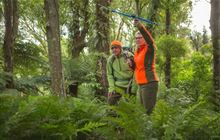Bat inventory and monitoring
Introduction
This module describes methods to inventory and monitor bats both away and at roosts.How to use this module
- Read project planning guides.
- Read the methods to inventory and monitor bats.
- Consult the introduction and the comparative tables and decision trees to help you select the method(s) most appropriate for your study.
- Be aware of the minimum data collection standards for methods.
- Check if any training is available for this method.
Introduction
How to decide the best method for bat monitoring (PDF, 1,183K)
Read this introduction and consult the comparative tables and decision trees to help you decide the method(s) best suited for your project objectives.
Methods
Counting away from roosts
Counting away from bat roosts: bat detectors on line-transects (PDF, 964K)
This method inventories long-tailed bats where observers use hand held bat detectors and systematically survey for bats along transects.
Counting away from bat roosts: automatic bat detectors (PDF, 1,285K)
This method remotely inventories bats where observers establish bat detector units.
Counting away from bat roosts: visual counts (PDF, 723K)
This method is useful to identify where long-tailed bats may be roosting.
Inventory and species identification of bats (PDF, 801K)
This method is used in areas where bats commute and forage, to record their presence, confirm species identity, calculate estimates of relative abundance and to estimate population size and survival.
Exit counts at roosts
Exit counts at bat roosts: cameras and recorders (PDF, 1,101K)
Use this method to count bats at their roost sites by filming and recording evening emergence with infrared cameras and recorders.
Exit counts at bat roosts: simple visual counts (PDF, 953K)
This method is suitable for counting long-tailed bats when they leave roosts while it is still light without cameras or video equipment.
Trapping at roosts
Trapping at bat roosts: estimating population size (PDF, 875K)
This method can estimate a population of bats from catching a sample of bats at a roost.
Trapping at bat roosts: estimating survival and productivity (PDF, 1,090K)
This method can calculate survival statistics based on mark-recapture of bats sampled at roosts.
Roost occupancy and bat activity
Roost occupancy and indices of bat activity: infrared beam counters (PDF, 901K)
This method can gain an index of activity of bats at a roost by mounting infrared sensors and counters directly outside a roost exit.
Roost occupancy and indices of bat activity: field sign (PDF, 890K)
This method is suitable for establishing whether a site has been, or is being, used by roosting bats.
Roost occupancy and indices of bat activity: automatic bat detectors (PDF, 805K)
This method can determine the presence or absence of long-tailed and lesser short-tailed bats at roosts using automated devices.
Counting bats inside roosts (PDF, 829K)
This method can count bats roosting in caves and buildings. It is unsuitable for counting bats inside trees.
Casual reports of bats (PDF, 844K)
This method can be used to record casual sightings of bats on DOC bat databases, and provides guidance on how the information can be used and interpreted.
Other documents
DOC best practice manual of conservation techniques for bats (PDF, 4,690K)
This manual has information on techniques to manage and to undertake research on bats. It should be consulted when selecting and/or applying a inventory or monitoring method.


